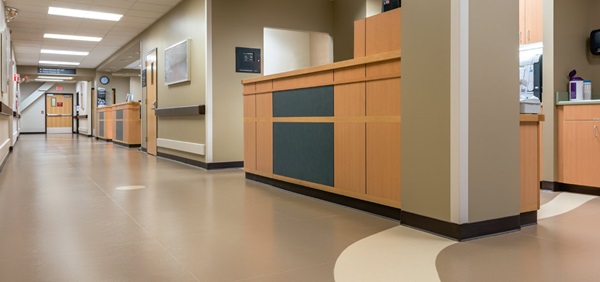
More than 2.9 million strong, registered nurses (RNs) make up the largest component of the healthcare workforce in the U.S. Day-to-day, these professionals experience a strenuous combination of physical and mental demands, resulting in increased levels of fatigue.
nora by Interface evaluated how factors of the physical healthcare environment (PHE) contribute to nurse fatigue. The effects were found to have influence at the personal and organizational levels as well as the profession at large. The findings demonstrate healthcare organizations' ability to mitigate and prevent nurse fatigue and its effects through the PHE.
Nurse Fatigue Impact and Contributing Factors
Nurses can experience fatigue as an acute phenomenon or a chronic condition. It manifests in physical, mental and emotional symptoms, such as musculoskeletal injuries, emotional disorders, job dissatisfaction and burnout. These impacts are exacerbated across the country due to a lack of opportunity for recovery. In fact, 85% of nurses report suffering from job-related fatigue, while 63% indicate they have experienced burnout due to their work.
Though several recent studies utilizing the Systems Engineering Initiative for Patient Safety (SEIPS) model as a framework provide evidence that the PHE contributes to nurse fatigue, little evidence exists to date to support how the PHE impacts nurse fatigue. When integrated with individual, organizational and policy interventions, the PHE can provide a comprehensive approach to address nurse fatigue.
A Conceptual Framework
This study portrays nurse fatigue as a multi-faceted construct. It revealed four categories representing the various dimensions of nurse fatigue – physical, cognitive, emotional and psychosocial – as well as 19 sub-codes identifying types of fatigue. Further, four environmental factor categories were identified as impacting nurse fatigue – ergonomic, sensory, layout and restorative – along with 27 sub-codes denoting design elements within the PHE.
Though this complexity makes it difficult to identify which PHE design elements contribute more or less to fatigue, the effects were cumulative, resulting in increased internal pressures, and decreased care quality, internal motivation and knowledge base.

Addressing Fatigue Through Thoughtful Design
The study’s evidence demonstrates how, within the larger nurse work system, the environmental component can support efforts to mitigate and prevent nurse fatigue. The design elements discussed and identified by participants provide specific opportunities to impact those who deliver care. Whether renovating or designing, it is critical to consider these design elements and how best to integrate within the health care facility to support efforts to reduce nurse fatigue.
For more information on how the PHE can impact nurse fatigue, download our whitepaper here.

 USA | English (US)
USA | English (US)